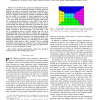Free Online Productivity Tools
i2Speak
i2Symbol
i2OCR
iTex2Img
iWeb2Print
iWeb2Shot
i2Type
iPdf2Split
iPdf2Merge
i2Bopomofo
i2Arabic
i2Style
i2Image
i2PDF
iLatex2Rtf
Sci2ools
114
click to vote
PAMI
2010
2010
Order-Preserving Moves for Graph-Cut-Based Optimization
— In the last decade, graph-cut optimization has been popular for a variety of labeling problems. Typically graph-cut methods are used to incorporate smoothness constraints on a labeling, encouraging most nearby pixels to have equal or similar labels. In addition to smoothness, ordering constraints on labels are also useful. For example, in object segmentation, a pixel with a “car wheel” label may be prohibited above a pixel with a “car roof” label. We observe that the commonly used graphcut α-expansion move algorithm is more likely to get stuck in a local minimum when ordering constraints are used. For a certain model with ordering constraints, we develop new graphcut moves which we call order-preserving. The advantage of orderpreserving moves is that they act on all labels simultaneously, unlike α-expansion. More importantly, for most labels α, the set of α-expansion moves is strictly smaller than the set of order-preserving moves. This helps to explain why in practice ...
Label | Order-preserving Moves | PAMI 2010 | Pixel |
Related Content
| Added | 29 Jan 2011 |
| Updated | 29 Jan 2011 |
| Type | Journal |
| Year | 2010 |
| Where | PAMI |
| Authors | Xiaoqing Liu, Olga Veksler, Jagath Samarabandu |
Comments (0)

